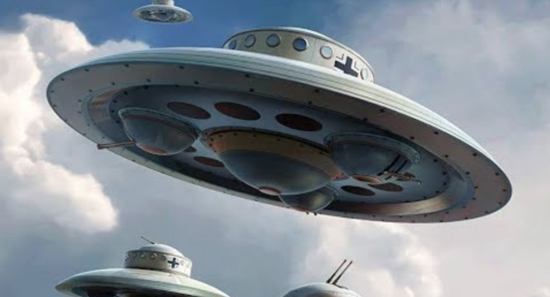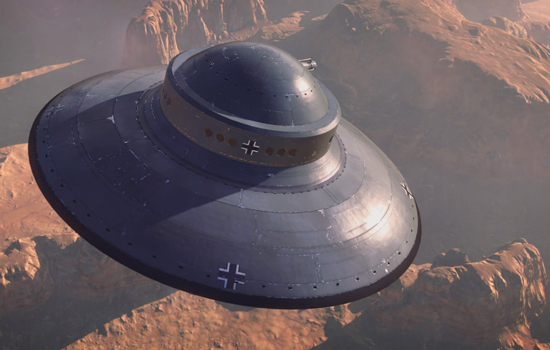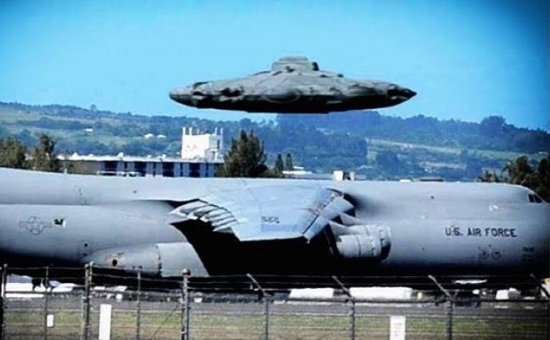UFOs and the Secret German Space Program
by Michael Shrimpton

Right after taking office, the Trump Administration has been briefed on the aliens subject and didn’t walk into a bear-trap, like poor old President Reagan did. Trump has been making some excellent appointments, with respect to this subject. In particular he has appointed a strong national security team. He’s also had a briefing from the Mossad director, so he knows about the alien bases on Earth and the threat from Dachau.
UFOs
I know this is of huge interest to many readers and the public at large. Knowing who else is out there is also of fundamental importance to humanity.
However, the field has been cluttered up with disinformation. As I explain in Spyhunter, a whole bunch of German scientists and aircraft designers dropped out of sight at the end of World War II. Not all went to work for the Allies. It is perfectly clear that there was a secret German space program after 1945.
Some of this was run out of India, some out of South America and some out of the UK, USA and USSR, with technological developments the Allies paid for being stolen and used in the secret space program.
Needing an explanation for strange objects appearing in the sky, the Propaganda Section came up with the cunning plan of blaming extra-terrestrials. The secret space program penetration inside CIA & FBI, the Correa/COREA Group, easily sold this concept to the CIA top brass, as the agency had a secret program all of its own.
The boys even had their own secret air base at Groom Dry Lake in Nevada, known to all UFOlogists as Area 51. ‘Bill’, the nice U-2 pilot to whom I refer in Spyhunter, was there when Tony LeVier first took a U-2 up for a spin and was part of the U-2 and SR-71 shakedown programs.
The idea of UFOs was pushed by two German agents in particular, Read-Admiral Roscoe Hillenkoetter, the CIA’s first director, and ex-Marine Corps flier Major Donald Keyhoe, whose books on flying saucers became influential. I remember reading one as a boy.
The problem of course is that neither Hillenkoetter nor Keyhoe were acting in good faith. Everything they wrote and said about UFOs – and much more besides – is suspect.
The same goes for anybody flashing a badge from a German-penetrated agency such as the FBI or the CIA, or from defense contractors dependent upon orders from Uncle Sam. Secret approaches from government agents bearing “suppressed” news about UFOs can be very flattering, but should be viewed with reserve.
The strategy has worked time and again. A variation is the release of official documents about UFOs, invariably dating back to administrations under German control, or where the President happened to be a German agent. Dwight D. Eisenhower was a past master at this. Pretty much anything from the Eisenhower Administration hinting at extraterrestrial visitations can be tossed straight in the trash, especially if marked “Top Secret” or above. The best disinformation is marked “Top Secret”.
UFO sightings
There have been thousands of these since the late 1940s, when the UFO scam kicked off. Nearly all can be discounted, either because the observers were simply seeing something they wanted to see, or lacked aviation literacy and were easily confused.
Some have simply been made up, either by over-keen UFOlogists, or by the secret space program, or one of its sub-agencies. Genuine sightings by pilots or the military shouldn’t be discounted, but many of these are sightings of either US or German aircraft or spacecraft on the secret list.
Faking UFO imagery has almost become an industry. Some of the fakes are well-meaning, of course, in the sense that the people making them genuinely believe in UFOs and are just trying to help the cause. Others are done for profit, or as part of the German disinformation campaign. In over 60 years, many images of extraterrestrial craft are actually ships created in the secret space program.
The Secret German Space Program

This is not to say that there have been no genuine sightings of unknown spacecraft. There have been whispers for years about NASA astronauts sighting other craft in space, when no other launch has been scheduled. I would not be in the least bit surprised to learn that the secret German space program shadowed US spacecraft up to the 1970s, probably launching from now-abandoned covert bases in the more remote parts of South America.
How much of this covert space program survives and how far they got are open questions. I doubt they got as far as Mars, but they might have reached the Moon. The secret space program murderous hostility to the Apollo program was notable. They tried very hard to strangle the program at birth and were eventually able to cut it short, citing budget pressures, which they helped to create. I believe we (Americans) still haven’t got beyond the Moon, sadly.
These are fascinating space mysteries. I don’t pretend to have all the answers, indeed I look forward to finding them out!
Is There Intelligent Life Elsewhere In The Universe?
This question of course assumes that there is intelligent life here on Earth. Reading the mainstream media you could be forgiven for doubting it, but overall, with exceptions, human beings are intelligent.
I am quite sure that there is intelligent life elsewhere in the universe. We might even find life, albeit microbial, elsewhere in the Solar System, Europa (the smallest of the four Galilean moons orbiting Jupiter) being perhaps the best prospect. There are simply too many planets in our own galaxy and too many galaxies for there not to be.
It would be the height of hubris for us to assume that we are alone. It would also be rather boring not to have intelligent alien company whom we could invite around for a fresh juice and a game of chess (Scrabble might be a bit unfair!). Since we can’t guarantee that any extraterrestrials out there would be friendly, it would also be exceedingly silly for us to assume that we are alone.
However, I must sound a note of caution. I don’t think that either our galaxy or the rest of the universe is exactly teeming with intelligent life. The more we learn about our own origins and the formation of the solar system the more remarkable it is that we came about.
There is much talk of so-called “Goldilocks” planets – not too hot and not too cold. I have no doubt there are a lot of goldilocks planets in our own galaxy, probably tens of thousands and possibly hundreds of thousands of them.
There seem to me to be three main problems, which help explain why the boys on Apollo 11 didn’t have to worry about colliding with UFOs on their way to the Moon (and yes, they did get there!):
1. Rotation;
2. Time; and
3. Surviving Nuclear Energy.
Not all planets rotate. Ours does, as a consequence of an ancient collision with a planetoid, creating the Moon. The monumental energy imparted by that impact is gradually being lost, which is why Earth’s rotation is slowing down, albeit imperceptibly.
It is very difficult to see how intelligent life could emerge on a stationary planet. One side of the planet would always be too hot and bright, the other too cold and dark. Tides, bringing water onto land, also seem to be essential.
Then there is time. The galaxy is as ancient as it is vast – it’s about 13 billion years old. That is time enough not only for civilizations to evolve but also to die out. There might have been a million civilizations in the Milky Way to date but only a thousand might have survived. We simply do not know, and won’t find out until we start exploring.
Most, if not all advanced civilizations are going to discover nuclear energy. In so doing they will have discovered the means to destroy themselves, if they are not careful. Not every civilization will have a Dick Walters or a Frank Roberts, both later friends of mine, to bail them out of trouble should a nuclear crisis arise.
Are Starships Possible?
One reason we can safely discount certain UFO sightings is that they are atmospheric, that is to say sightings of ships in the atmosphere, without supporting evidence of a mothership. The one place we would not find a starship is in the atmosphere. The most any extraterrestrial craft in the atmosphere could be is a shuttle or landing craft.
Whilst fusion energy would not require large amounts of fuel, the reactors themselves would be large, and there would have to be several, to provide redundancy. A starship would also need engineering spaces, accommodation for its crew and large holds to store food and spares, as well as control spaces.
One thing a starship would not be is small, nor is there any reason to suppose that it would be shaped like a saucer, indeed a tea-cup would be as sensible a shape as a saucer. The saucer shape seems to have been inspired by the pointless German wartime experiments into flying saucers, pointless in the sense that whilst they might have got a saucer off the ground, it didn’t do anything.

As I have observed before, Einstein was wrong about the speed of light being a limiting velocity. It isn’t. Interstellar travel is therefore perfectly possible in theory. Journeys however would be lengthy, even at multiples of light speed, as the distances are so vast. You can forget worm-holes and other short-cuts so beloved of science-fiction script-writers as a means of getting around Einstein’s artificial restriction on top speed.
Movie Review: Passengers (2016, dir. Morten Tyldum)
This brings me neatly to this movie review. Passengers is an enjoyable interstellar yarn, well-acted and stylish, where space is a backdrop to the developing romance between the two charming leads, Chris Pratt and Jennifer Lawrence.
Delightful as the movie is, it illustrates how NOT to do interstellar travel. The intrepid colonists aboard the Avalon need no fewer than 120 years to get to their destination, the fictional planet Homestead II.
The scriptwriters get some things about interstellar travel right. The Avalon is over 3,000 ft long, which is about the sort of size one would expect for an interstellar passenger liner. She uses fusion power, and has a system for deflecting gas molecules and other bits of interstellar debris. She slingshots around stars, which would no doubt give her a boost, although the movie doesn’t explain why she would need it, with an interstellar propulsion system or hyper-drive. The passenger modules rotate, simulating gravity.
Where it all goes wrong is the assumption that Einstein was right. The Avalon is limited to a top speed of 0.5C, or half-light. Anyone would think that there were speed cameras in space.
There are several insuperable problems with this, practical as well as psychological. The passengers have to reconcile themselves to never seeing their friends and loved ones again. In practice they are also committed to a one-way journey, although Aurora (played by Jennifer Lawrence) has purchased a round-ticket, silly girl. Her planned journey, of 240 years, would take longer than Chiltern Railways from Birmingham to London.
They also have to go into hibernation. Hibernation has been a feature of science-fiction movies and TV series since Lost in Space (the original TV series, I mean, starring Jonathan Harris, not the movie). No one has yet demonstrated that it is possible. Bears do it, but only for the winter, and they age as they hibernate – they’re really only having an extended nap.
Our metabolism does not in fact slow down that much whilst we sleep. Slowing it right down seems to me to imply tissue damage, not least to the central nervous system and the brain. I doubt you’d be popping down to the bar a few hours after you wake up, as our lovebirds do, encountering a legless Michael Sheen, by which I mean an android barman without legs.
It’s not just the passengers who go into hibernation of course. The crew are also asleep. This is positively dangerous, not least if you’re going to navigate through star systems where there might be rather larger chunks of space debris than your electromagnetic field is designed to handle.
The plot does not explain where the meteoroid shower comes from – meteoroids, like asteroids and comets, orbit stars. They don’t just float around space. Anyway, the Avalon gets whacked by a meteoroid, and Jim Preston, Chris Pratt’s character, gets woken up 90 years too soon, which, since the crew are still all sound asleep, is just as well.
There is no way that you could send a starship into interstellar space with over 5,000 souls aboard and run it for decades on autopilot. There is also no way that you aren’t going to encounter engineering or software problems requiring human intervention over the course of 120 years. Would you trust Microsoft if they guaranteed the next edition of Windows for 120 years?
Luckily for our plucky space voyagers an engineer, well-played by Laurence Fishburn (Perry White from Man of Steel), is eventually awoken by the same software snafus which woke Jim. I won’t spoil the plot by revealing what happens then.
At no point does the movie address the psychological problem of intervening technological developments on Earth. If anyone were silly enough to attempt an interstellar voyage on this basis, they would soon find themselves overtaken by faster starships.
yogaesoteric
December 16, 2018
